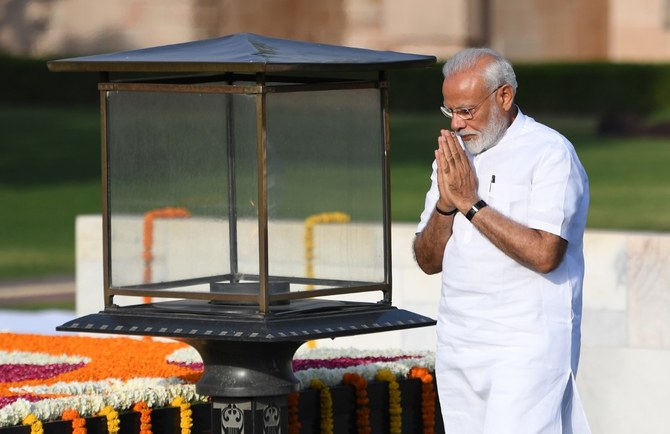Solomon2
BANNED

- Joined
- Dec 12, 2008
- Messages
- 19,475
- Reaction score
- -37
- Country
- Location

Middle East allies can help Modi deliver ‘good times’

AFSHIN MOLAVI
May 30, 201914:40

Indian Prime Minister Narendra Modi pays tribute at Rajghat, the memorial for Mahatama Gandhi, in New Delhi on May 30, 2019, the same day he will take oath for his second term. (AFP)
Indian Prime Minister Narendra Modi faces a range of problems in his second term, but he clearly does not have a popularity problem. By the sheer force of his personality, he managed another electoral landslide for his party, the Bharatiya Janata Party (BJP), in India’s recent elections. Modi has proven highly adept at getting elected and re-elected. The next step is to prove that he is highly adept at achieving inclusive, job-creating growth for India — something that eluded him in his first term.
Back when Modi won his first election in 2014, he promised “ache din” — good times — ahead. Markets reacted positively to the business-friendly former chief minister of Gujarat and the macro growth numbers looked good: Consistent annual growth above 7 percent. However, job growth has been far slower than economic growth, and the challenge remains daunting as India must create 10 million new jobs every year. The bumper sticker summary of Modi’s first five years would be “growth good, jobs scarce.”
Interestingly, Modi made the Middle East region, particularly outreach to Saudi Arabia and the UAE, a key priority of his foreign policy in his first term. Despite all of the commentary about the BJP’s uneasy relations with India’s 200 million-strong Muslim community, this has not stopped the prime minister from engaging in an energetic foreign policy aimed at key Muslim states. Some of this goes back to the good times he promised.
After all, if India is to achieve the economic heights that Modi has declared, the country will need massive amounts of investment. In fact, Finance Minister Arun Jaitley estimated that India will need $1.5 trillion in infrastructure investment over the next decade to reach the 8 percent growth needed to create adequate jobs for India’s youthful population.
Generally speaking, when you are an emerging market country and you need large-scale infrastructure investment, there is one address to call: Beijing. However, India’s suspicion of Belt and Road projects and China’s wide-ranging $62 billion investment program in Pakistan mean that will be mostly off-limits. Japan has already filled the gap with major infrastructure projects in India, and the Gulf Cooperation Council (GCC) states might be next.
Indeed, the UAE has already been an active investor in India. DP World, the Dubai-based ports operator, already runs five ports in India and has pledged up to $3 billion in investments. The Abu Dhabi Investment Authority, the sovereign wealth fund of the UAE, was the first major anchor investor in India’s National Investment and Infrastructure Fund, with Saudi Arabia likely to follow suit.
During the February 2019 visit of Crown Prince Mohammed bin Salman to India, he announced a potential $100 billion in investments, signing accords on tourism, housing, broadcasting and infrastructure, among others. Time will tell what the numbers truly amount to, but even such ambitious goals reflect the growing commercial dynamism between India and Saudi Arabia.
The bumper sticker summary of Modi’s first five years would be 'growth good, jobs scarce'
Afshin Molavi
Afshin Molavi
Meanwhile, Saudi Aramco has joined hands with the Abu Dhabi National Oil Company and several Indian oil companies to invest up to $44 billion to build a refinery in the western Indian state of Maharashtra. However, the deal has hit some political hurdles as the chief minister of Maharashtra has called to relocate the refinery. With Modi re-elected, he will likely want to push this investment through quickly.
Despite Modi’s promises of a high-tech future for India, it is worth remembering that agriculture still provides about half of the country’s employment. The next robust phase of India-GCC cooperation could be in the food security area, as the Gulf nations seek to ensure their food security and India hopes to boost its agribusinesses. On a recent visit to the UAE, I heard a significant amount of talk about this growing nexus between New Delhi and Abu Dhabi.
Lastly, another area of growth and cooperation can be India’s aviation sector. According to the International Air Transport Association, aviation supports 7.5 million jobs in India and accounts for about 1.5 percent of the economy. India’s domestic aviation sector has seen double-digit monthly growth for the past five years and is on track to become the third-largest aviation market in the world by 2024.
Carriers and airports from the GCC region play a vital role in India’s international air connectivity. Nearly one-third of all international flights that leave India land in the UAE, and nearly a third that land in India hail from the UAE. Clearly, the UAE has emerged as India’s major air hub to the world. While Emirates airline gets much of the attention, Indian carriers transport more passengers to Dubai than UAE carriers.
As India moves from roughly 60 million international passengers flying today to 85 million by 2020, GCC air hubs will play a key role.
Modi’s promise of labor-intensive manufacturing jobs as part of the “Make in India” campaign have not materialized. To find that elusive “ache din,” Modi may need to find other sources of job growth, from infrastructure to agriculture to aviation — and key Middle East allies will play a more prominent role than expected.
• Afshin Molavi is a senior fellow at the Foreign Policy Institute of the Johns Hopkins University School of Advanced International Studies and is the editor and founder of the New Silk Road Monitor. Twitter: @afshinmolavi
Disclaimer: Views expressed by writers in this section are their own and do not necessarily reflect Arab News' point-of-view

